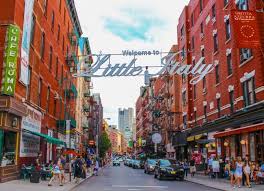Bronx’s very own Little Italy

New York: The Bronx has its share of fabulous attractions: Yankee Stadium, the Bronx Zoo, and the New York Botanical Garden, to name a few.
It also has, to some local chagrin, the Joker stairs. There’s another draw, though, that’s hallowed by many but perhaps unfamiliar to those who’ve never ventured to New York City’s northernmost borough: the Bronx’s very own Little Italy.
Technically named Belmont, the neighborhood is also known colloquially as “Arthur Avenue,” which is the street that’s home to a belt of red-sauce restaurants and family-run businesses, several of which date back about 100 years.
Many Italian immigrants settled in the area around the early part of the 20th century, and residents have become more diverse in the decades since. Today, the Bronx’s Little Italy is populated by several ethnic communities — Mexican, Puerto Rican, and Albanian are among the most prominent. And the Italian roots remain, because of the shops and eateries that continue to thrive.
Strolling down Arthur Avenue and the intersecting East 187th Street is a bit like time traveling. You’re transported to an era when merchants were called “merchants” and they made conversation with weekly customers, when patrons picked up their meats, mozzarella, and bread from dedicated shops. To the faithful, Arthur Avenue is a preserved piece of Old New York; to those who don’t know better, it’s a nameless part of a borough they can’t be bothered to visit.
“It always surprises me both how many people know of Arthur Avenue and how many people still don’t,” says Frank Franz, 66, treasurer and member of the executive board of the Belmont Business Improvement District. “I’ll be in other parts of the country and hear people talking about Arthur Avenue. And yet, there’s people right in the Bronx that don’t even know what’s going on up here.”
Getting to Arthur Avenue is, of course, simplest via transportation app. Ask your driver to drop you at the corner of Arthur and East 187th, and you’ll be right by Full Moon Pizza, where the slices are large enough to live up to the name. By subway, you’ll have to take the 4, B, or D trains to Fordham Road, and then either ride the Bx12 bus east, or walk down the thoroughfare that is Fordham Road; you could also take the 2 or 5 trains over to Pelham Parkway and then head west, on the Bx12 or on foot. If you prefer Metro-North, commute to the Fordham stop, then walk east, past Fordham University, and hook a right on Arthur Avenue.
Once you’re in Little Italy, you’ll notice a few differences from its Manhattan counterpart. There really aren’t any sidewalk maître d’s corralling passersby into restaurants (at least not in the daytime); novelty license plates and Godfather-referencing T-shirts are present but scarce; and there’s no Christmas ornament superstore spoiling the ambiance.
What you will spot is an array of bakeries and pastry shops, a couple of storefronts selling coffee beans and trinkets fit for Nonna’s display case, and a handful of butcher shops hoping to lure in anyone with a taste for tripe or lamb leg.
Now, Manhattan’s Little Italy isn’t simply the tourist trap that it’s often dismissed as — the gift-shop-plagued neighborhood still retains some of its charm, character, and longtime locals — but there’s no denying that it’s usually mobbed by out-of-towners who also have Times Square on their itinerary. By contrast, Arthur Avenue has the — come si dice — air of a more neighborhoody neighborhood. Don’t be mistaken: Arthur Avenue definitely attracts its own share of tourists. But there’s a sense that many of the people patrolling the sidewalks and chit-chatting at the cash registers are right at home.
To hear businessowners tell it, Arthur Avenue depends on a network of regulars from all over the tri-state area, including people who used to live in the neighborhood back when its makeup was more Italian, and who still have a fondness for all the fresh ingredients and throwback service. And that abundance of fresh products is another key distinction between NYC’s two versions of Little Italy: Manhattan’s is more about destination dining, while the Bronx’s is more about destination shopping.





